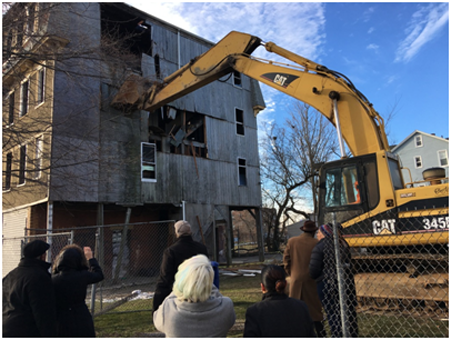Last July, Bridgeport Mayor Joseph P. Ganim ratcheted up his city”™s efforts to improve the quality of life with a new get-tough cleanup and redevelopment initiative
“We are declaring war on blight and illegal dumping,” Ganim said at the time. “That means zero tolerance for anyone who disrespects the residents of this city and our neighborhoods by just leaving their trash in an abandoned lot or letting their house go to waste. We will find those responsible and bring criminal charges against them. Just dumping trash and leaving a blighted property in Bridgeport are going to cost you. We are also asking for the public”™s help in finding the bad actors here so we can clean up our city, and we are now offering a reward for anyone who gives us a tip that leads to an arrest for blight or illegal dumping.”
Ganim”™s announcement of the city”™s Anti-Blight Pilot Program came as Bridgeport was weighted by a financial burden in trying to beautify its neighborhoods. During the first half of 2016, the city paid nearly $100,000 to remove approximately 300 tons of debris from more than 1,110 illegal dumping sites.
 Last month, Ganim”™s administration began to take a wrecking ball to abandoned properties in the East End by demolishing a fire-destroyed property at 1081 Stratford Ave. that housed the Petteway Market along with a social club and apartments. It marked the first in a series of demolitions aimed at severely rundown commercial and residential properties.
Last month, Ganim”™s administration began to take a wrecking ball to abandoned properties in the East End by demolishing a fire-destroyed property at 1081 Stratford Ave. that housed the Petteway Market along with a social club and apartments. It marked the first in a series of demolitions aimed at severely rundown commercial and residential properties.
“We will continue to be aggressive identifying what buildings can be saved and redeveloped and what buildings are an eyesore and a health hazard and need to come down so we can transform the neighborhood,” Ganim said. “My administration is committed to reviving the East End of Bridgeport and making this neighborhood the prosperous residential, commercial and cultural center it was historically. This will improve the quality of life for all the neighbors living near this blighted lot.”
Since the anti-blight campaign was launched, Bridgeport has begun to see movement on several levels. According to Av Harris, the city”™s director of communications and senior advisor for public policy, $110,000 in blight-related fines have been collected while a new volley of legal action has produced results in property-related cases.
“A total of 2,160 cases have been dealt with regarding blighted properties in Bridgeport,” said Harris. “Within this, 1,570 matters have been resolved dealing with blighted properties, 402 cases are in process, 132 cases are pending hearings and legal action has been taken on 56 cases. Approximately 26 properties are going through the process for demolition citywide.”
In a city where neighborhood blight has been a longstanding burden, the pilot program to combat it was a long time in the making, said Thomas F. Gill, the city”™s economic development and planning director, who was apopoitned to the office by Ganim in July.
“It didn”™t take long to recognize,” Gill said. “There was immediate recognition that this was a basic quality of life issue and a basic economic development issue. But it took thought and planning to gear up and staff up. It”™s an interdepartmental effort and there are fairly long lead time processes involved that require public notice, due process and hearings.”
Operating on a budget of approximately $3 million, the anti-blight effort is dealing with a variety of underlying issues, Gill noted.
“Some are private owners who”™ve not been able to keep up. Some are properties that have experienced fire damage. Some are bank-owned. Some are abandoned properties that fall to the city as the owner of last resort,” Gill said.
The city”™s anti-blight action “depends on the underlying ownership structure of the blighted property,” he said. “If the city is owner of an infill (empty) lot, we will look to resell to abutters or to local housing developers. Larger, commercial properties, again if owned by the city, will be repositioned via RFP (request for proposals) for redevelopment. If properties are privately owned or bank-owned, we will cooperatively market such sites to the extent we can and insist that they be maintained as clean lots in the meanwhile, and use blight fines as enforcement should they not be.”
The mayor”™s office is especially targeting blight in the city”™s East End. Gill said the administration has specific plans on revitalizing the neighborhood.
“There are improved retail options,” he said. “Seaview Plaza includes over 120,000 square feet of new, needed retail including a 40,000-square-foot full-service grocery and a pharmacy. At Seaview Plaza, the entire site will be providing public waterfront access, including a public promenade carrying across the Steelepointe waterfront amenities and providing a boat ramp. There will be an improved Stratford Avenue with new rental housing, new retail offerings, a new library and increased homeownership from Seaview Village, infill sites and in major developments like the Civic Block.”
Gill said city officials “are also looking for a more environmentally just neighborhood” in the East End. While working to reclaim Johnson”™s Creek, the city in April issued a cease-and-desist order for the O&G Industries recycling plant at 1255 Seaview Ave., where construction debris was being dumped. Ganim claimed the construction company lacked a municipal certificate for debris storage.
In the East End, “We want a better transportation infrastructure ”” Barnum train station, Seaview Avenue improvements ”” and better educational opportunities with a new Harding High School,” Gill said. “And more job opportunities in small business, niche manufacturing, arts-based businesses, retail and support for Yale-Bridgeport Hospital”™s growth.”
Mickey Herbert, president and CEO of the Bridgeport Regional Business Council, praised the anti-blight effort as a win-win for the city and its commercial prosperity.
“We”™re all about the image of Bridgeport,” he said. “Anything that is done to eradicate blight is good for existing business and for businesses considering a move to Bridgeport ”” and we get those inquiries all of the time. In fairly short order, you”™ll see significant remediation in the city and it will look better than in the past.”
However, Razul Branch, a contractor with Bridgeport Neighborhood Trust, a nonprofit developer and manager of affordable housing, cautioned that some property owners targeted in the blight campaign are more deserving of outreach than a wrecking ball.
“From what I have observed, a lot of properties are owned by elderly people who don”™t have the funding to pay people to come in and help with the upkeep,” Branch said. “I hope for mediation or a service to help them so they are not hit so hard. That would be a great addition improving the blight situation.


















